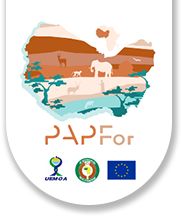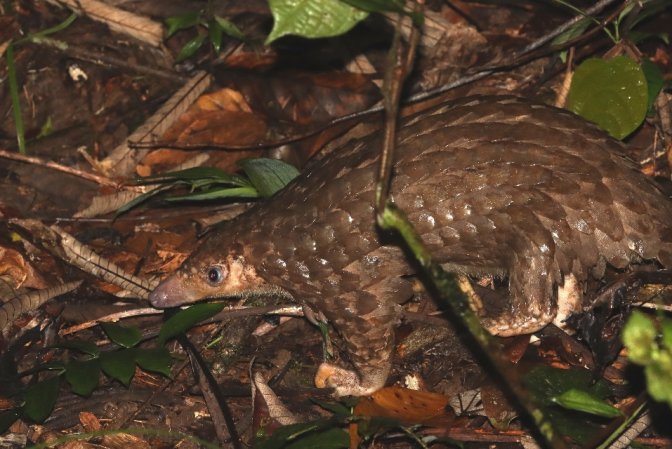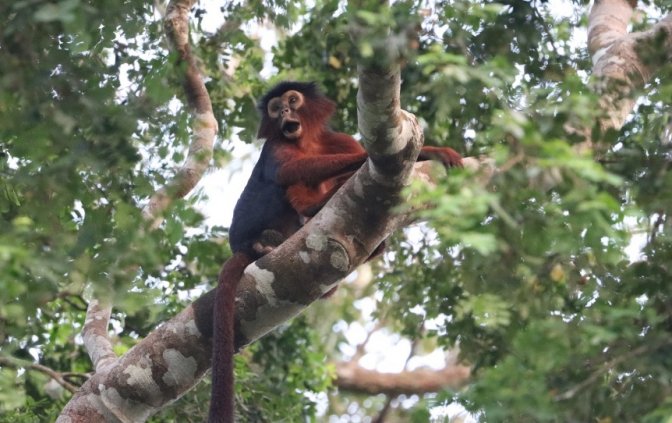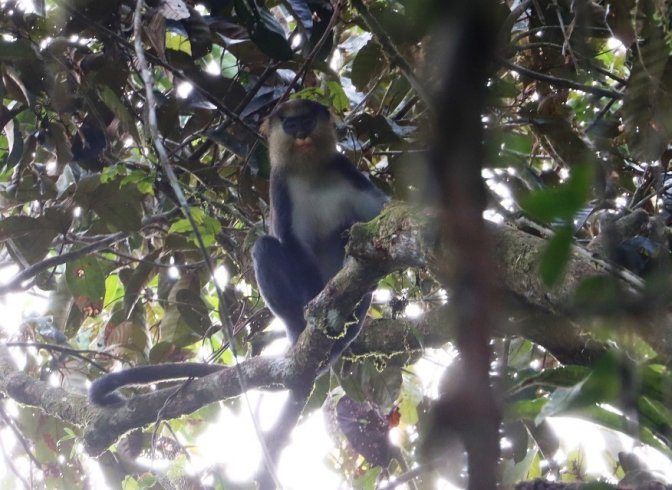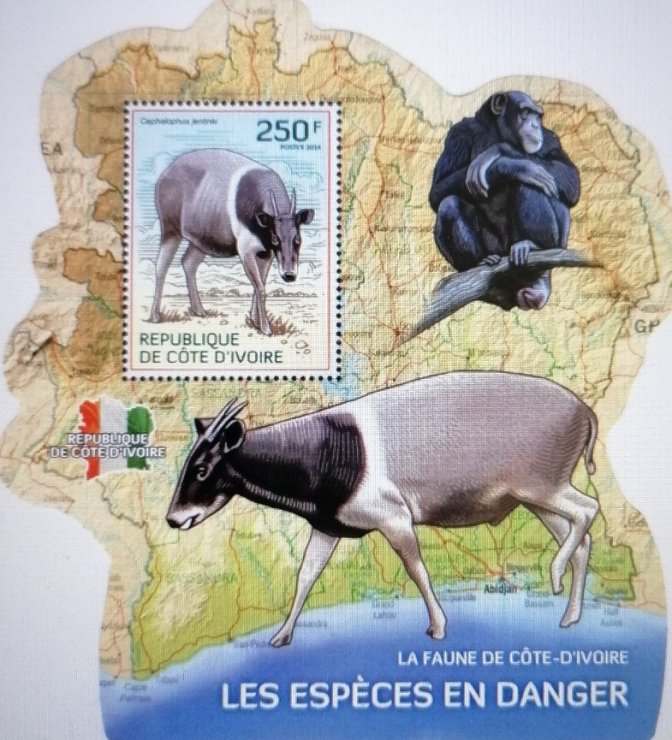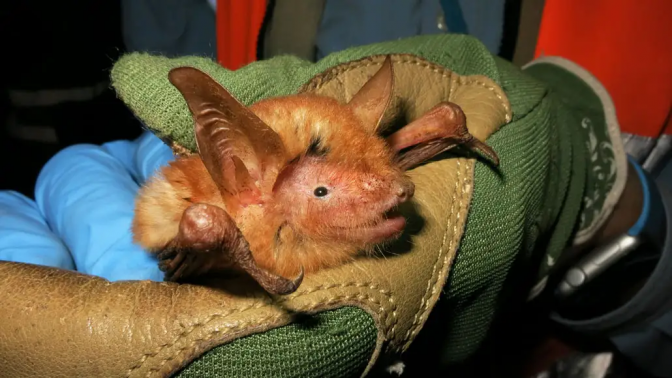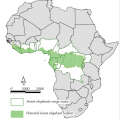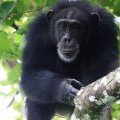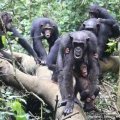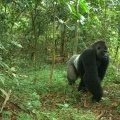Home / Guinean forests / Characteristics / The biodiversity / Animals / Mammals
Mammals
There are over 300 species of mammals, ranging from forest elephants that weigh up to six tonnes to shrews that can weigh less than 10 grams.
The forest elephant
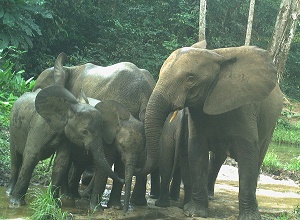
The African forest elephant (Loxodonta cyclotis) is the cousin of the African savanna elephant (Loxodonta africana) and the Asian elephant (Elephas maximus). It is smaller, especially with shorter and straighter tusks, than the savannah elephants, adapted to the forest environment where it is more difficult to move through the dense undergrowth. It is generally found in the dense forest of Central and West Africa, but is also sometimes on the edge of forest territory, just like the savannah elephant, with which it can breed and have viable and healthy offspring.
The pygmy hippopotamus
An unusual species, emblematic of the forests of Upper Guinea
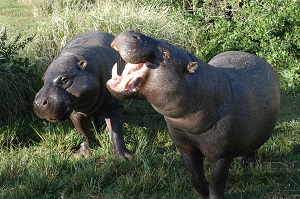
The pygmy hippopotamus (Choeropsis liberiensis) is a species of hippopotamus native to the forests and swamps of West Africa. It is the cousin of the much better known and larger so-called ‘amphibian’ hippopotamus.
It is considered one of the 10 species most in need of protection, to prevent its disappearance.
See its identity sheet
Pangolins of the Guinean Forests
Pangolins are exceptional mammals in many ways. The strangest and best-known feature is that they are covered mainly in scales and not hair, except on their bellies. This allows them to curl up into a ball when they feel threatened and escape the fangs of their predators. The name "pangolin" comes from the Malay word ‘pengguling’ meaning ‘one who curls up into a ball’. A second characteristic is that they feed almost exclusively on ants and termites. They do not have teeth, but they do have an extremely long tongue, which, when unrolled, is as long as their body.
There are four species of pangolin in Africa, three of which live in PAPFor landscapes:
| English names | Scientific names | OKKPS | Gola-Foya | WWZ | Nimba | TGKS | Cross River |
| Black-bellied pangolin | Uromanis tetradactyla | X | X | X | X | X | |
| White-bellied pangolin | Phataginus tricuspis | X | X | X | X | X | X |
| Giant Ground pangolin | Smutsia gigantea | X | X | X | X | X |
See the species identity card for the black-bellied pangolin.
Primates of the Guinean forests.
Primates are a group of mammals with a special place in every culture, not least because they are biologically very close to humans. As a result, they are excellent ’ambassadors’ for conservation programmes.
West Africa is home to 40 species of primate, 7 of which live in savannahs or dry forests and 33 in forests. Of these forest species, no fewer than 23 are strictly endemic to Guinean forests.
The table below lists the primate species found in Guinean forests and their distribution.
Galagidae
| Scientific name | Common name | Distribution |
| Galagoides demidoff | Demidoff’s galago | African forests |
| Galagoides thomasi | Thomas’s galago | African forests |
| Euoticus pallidus | Pallid galago | SE Nigeria to SW Cameroon |
| Sciurocheirus alleni | Allen’s squirrel galago | SE Nigeria to SW Cameroon |
Lorisidae
| Scientific name | Common name | Distribution |
| Arctocebus calabarensis | Calabar angwantibo | SE Nigeria to SW Cameroon |
| Perodicticus potto | Common potto | Senegal to Ghana & Kenya |
| Perodicticus edwardsi | Milne-Edwards’s potto | Nigeria & Central Africa |
Cercopithecidae
| Scientific name | Common name | Distribution |
| Cercocebus atys | Sooty mangabey | Senegal to W Côte d’Ivoire |
| Cercocebus lunulatus | White-naped mangabey | Côte d’Ivoire to Ghana |
| Cercocebus torquatus | Red-capped mangabey | W Nigeria to S Gabon |
| Mandrillus leucophaeus | Drill | SE Nigeria to SW Cameroon |
| Allochrocebus preussi | Preuss’s monkey | SE Nigeria to SW Cameroon |
| Cercopithecus diana | Diana monkey | S Guinea to W Côte d’Ivoire |
| Cercopithecus roloway | Roloway monkey | S Côte d’Ivoire à E Ghana |
| Cercopithecus campbelli | Campbell’s monkey | S Senegal to E Liberia |
| Cercopithecus mona | Mona monkey | SE Ghana to SW Cameroon |
| Cercopithecus lowei | Lowe’s monkey | W Côte d’Ivoire to Ghana |
| Cercopithecus pogonias | Crested monkey | SE Nigeria to the DRC |
| Cercopithecus petaurista | Spot-nosed monkey | S Senegal to Togo |
| Cercopithecus erythrogaster | Red-bellied monkey | SE Togo to S Nigeria |
| Cercopithecus sclateri | Sclater’s monkey | SE Nigeria |
| Cercopithecus erythrotis | Red-eared monkey | SE Nigeria to SW Cameroon |
| Cercopithecus nictitans | Putty-nosed monkey | N Liberia to Central Africa |
| Procolobus verus | Olive colobus | Sierra Leone to W Côte d’Ivoire |
| Piliocolobus badius | Western red colobus | Sierra Leone à O Côte d’Ivoire |
| Piliocolobus waldroni | Miss Waldron’s red colobus | E Côte d’Ivoire to W Ghana |
| Piliocolobus epieni | Niger Delta red colobus | S Nigeria |
| Piliocolobus preussi | Preuss’s red colobus | SE Nigeria to SW Cameroon |
| Colobus polykomos | King colobus | S Senegal to W Côte d’Ivoire |
| Colobus vellerosus | Geoffroy’s colobus | C Côte d’Ivoire to W Nigeria |
| Colobus guereza | Guereza colobus | E Nigeria to East Africa |
Hominidae
| Scientific name | Common name | Distribution |
| Gorilla gorilla | Western gorilla | E Nigeria to Congo |
| Pan troglodytes | Common chimpanzee | S Senegal to Uganda |
Other West African primates (living in savannahs)
Galagidae
| Galago senegalensis | Senegal galago |
Cercopithecidae
| Papio papio | Guinea baboon |
| Papio anubis | Olive baboon |
| Erythrocebus patas | Patas monkey |
| Chlorocebus sabaeus | Green monkey |
| Chlorocebus tantalus | Tantalus monkey |
| Piliocolobus temminckii | Temminck’s red colobus |
The PAPFor programme is very important for the survival of many primate species. The six PAPFor landscapes contain a total of 26 species, most of which are endemic to the Guinean forests.
A few primate species of the PAPFor landscapes
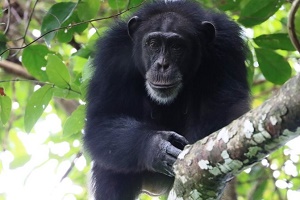
All the PAPFor landscapes are home to the chimpanzee (Pan troglodytes), which is an important conservation target. Of the four subspecies of chimpanzee in the world, one is endemic to the forests of Upper Guinea (Pan troglodytes verus) and another to the forests of Lower Guinea (Pan troglodytes ellioti).
Chimpanzees live mainly in forests, but also in wooded savannahs. Unfortunately, these habitats are increasingly threatened by the expansion of both smallholder and industrial agriculture. What’s more, although protected, this species is hunted either for its meat or to sell live individuals as pets. There are thought to be only 200 000 to 300 000 chimpanzees left in the world, a number that has been steadily declining for several decades, particularly in West Africa, where deforestation is the highest on the African continent. The species is considered "endangered" by the IUCN.
See its identity sheet.
The Cross River Gorilla
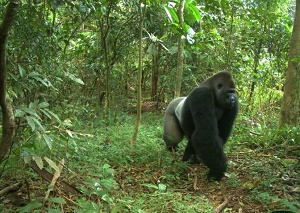
There are two species of gorilla in Africa. The Eastern Gorilla is found in the east of the Republic of Congo, Rwanda and Uganda, while the Western Gorilla is widespread from southeast Nigeria to the west of the Congo Basin. The latter species is itself made up of two distinct subspecies, the rarest and least widespread of which is the Cross River Gorilla (Gorilla gorilla diehli), found only in southeast Nigeria and southwest Cameroon.
Some other primates……
Among the species that live mainly in the canopy are various species of cercopithecus and colobus.
The Western red colobus (Piliocolobus badius) is found only in the forests of Sierra Leone to the west of Côte d’Ivoire. It is found in several protected areas across four PAPFor landscapes: Gola-Foya, Wologizi-Wonegizi-Ziama, Mount Nimba and Tai - Grebo-Krahn - Sapo.
Carnivores of the Guinean forests
From a taxonomic point of view (the classification of species), the term carnivore corresponds to an Order within the Class of Mammals, which includes the Canidae, Felidae, Genets, Mustelidse and a few other related families. There are 29 species of carnivores in the Guinean forests, of which around half are typically forest-dwelling and the others are adapted to both forest and savannah environments.
The list of carnivores in Guinean forests
Some of these species have very restricted distributions, such as the Liberian mongoose (Liberiictis kuhni), which is the only species in the Liberiictis genus. It is only found between the St John River in eastern Liberia and the Sassandra River in western Côte d’Ivoire. This small carnivore prefers the banks of rivers and undergrowth where there are plenty of earthworms on which it feeds. Given its limited distribution and the threats to primary forests, this species is considered threatened by the IUCN. Given that its distribution corresponds almost perfectly to the Tai - Grebo-Krahn - Sapo landscape, the PAPFor programme is important for ensuring the survival of this unique species.
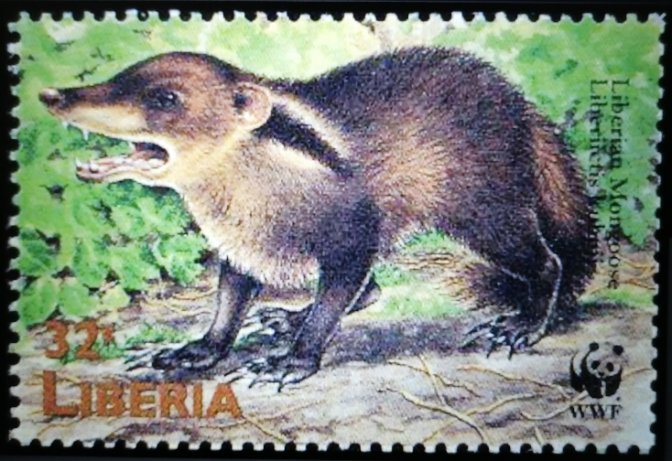
With a genus name (Liberiictis) referring to the country and a distribution practically limited to Liberia, this species is one of Liberia’s emblematic species.
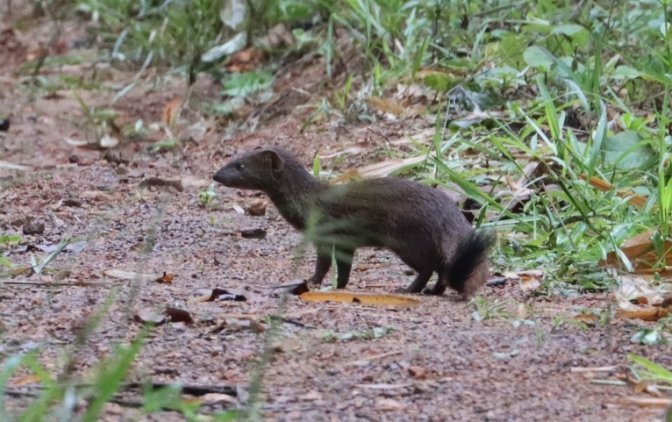
The Common slender mongoose, also known as the red mongoose (Galerella sanguinea), is fairly common in the peripheral areas of the Guinean forests.
And many other mammal species...
Other mammals typical of the Guinean forests include duikers, a genus of small forest antelopes. Several duikers are endemic, some of them emblematic because of their unique appearance. Of particular note are the Zebra duiker (Cephalophus zebra) and Jentink’s duiker (Cephalophus jentinki), both of which have virtually the same distribution: from eastern Sierra Leone to western Côte d’Ivoire. Here too, the PAPFor programme is important for the survival of these two species, which are found in the Gola-Foya, Wologizi-Wonegizi-Ziama and Taï - Grebo-Krahn - Sapo landscapes.
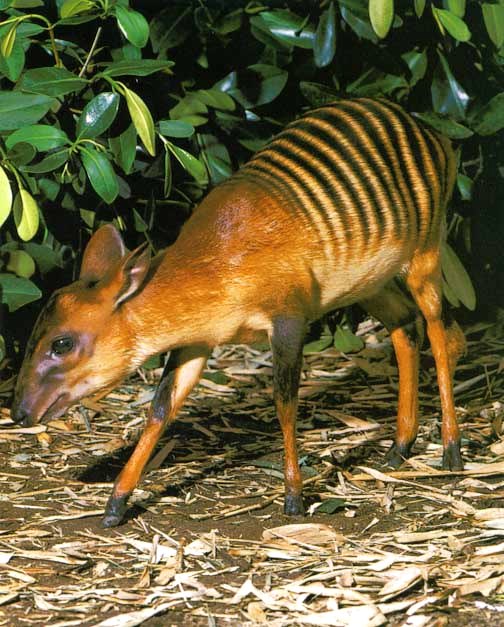
Guinea’s forests are also rich in rodents. As well as mice, field mice and rats, squirrels (Sciuridae) are a particularly well-represented group, with around 15 species, 4 of which are endemic to the forests of Upper Guinea.
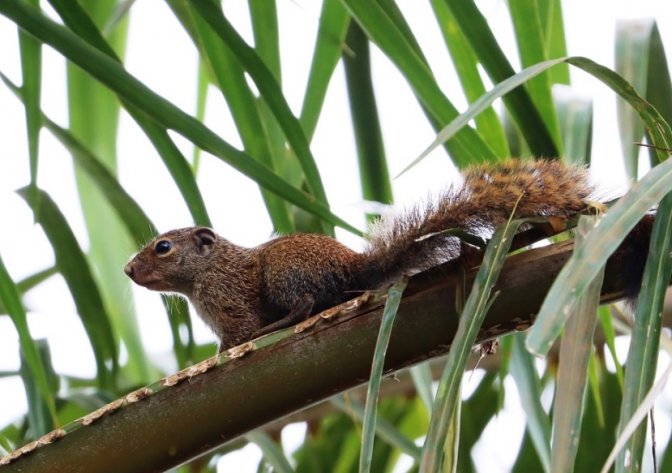
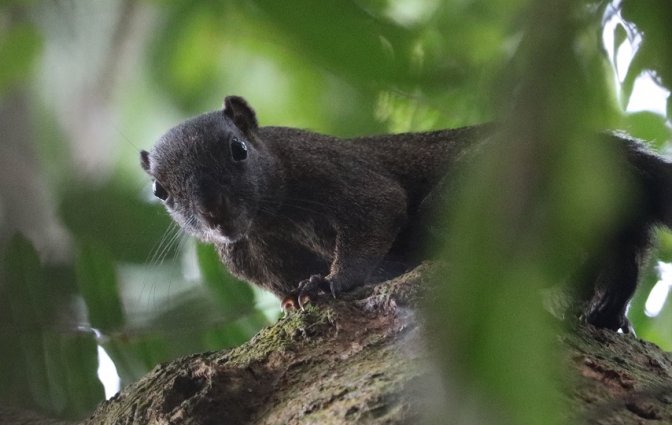
Bats are another important group of mammals, because of their ecology: insectivores regulate insect species, while frugivores play an important role in fertilising various plants, by facilitating pollination.
Bats are another important group of mammals, because of their ecology: insectivores regulate insect species, while frugivores play an important role in fertilising various plants, by facilitating pollination.
The Nimba mountain range is world-famous for its great diversity of bats. These include Lamotte’s round-leaved bat (Hipposideros lamottei), which is endemic to these mountains and is critically endangered. Even more surprising is the very recent discovery of a new species, also endemic to the Nimba Mountains, the Nimba Mountain bat (Myotis nimbaensis), which was only described in 2021.
